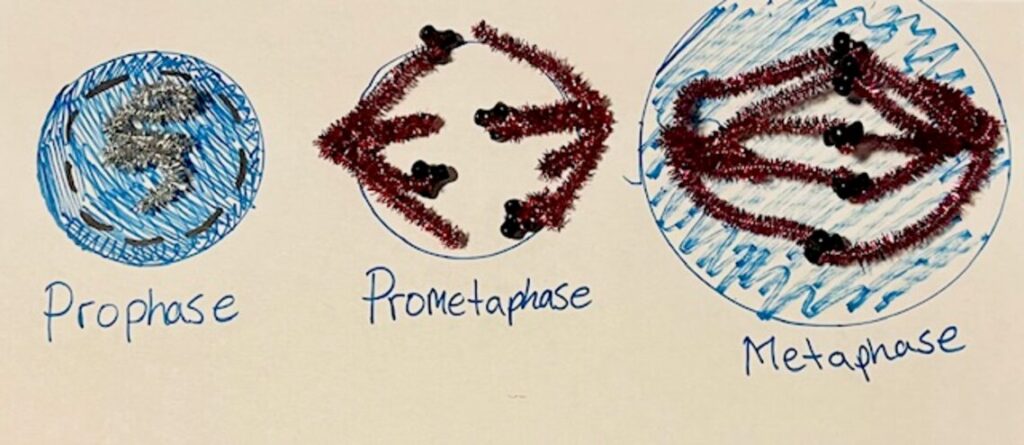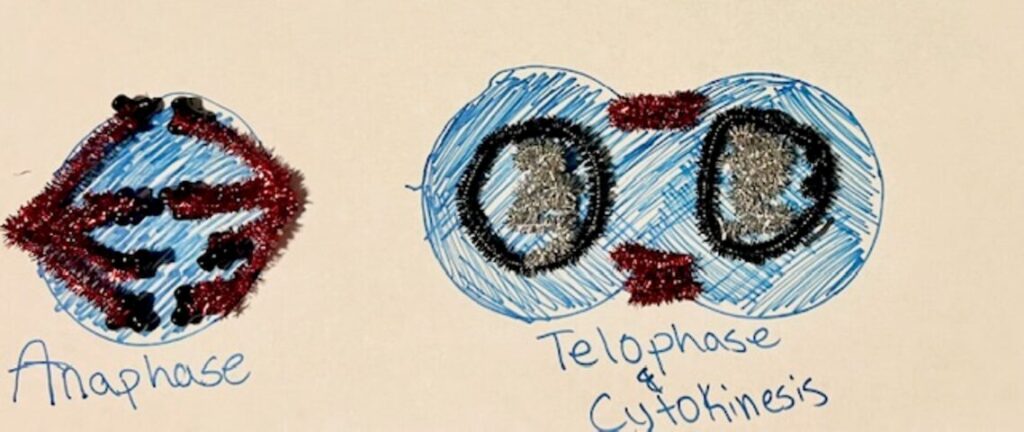I chose to do my STEAM project on Mitosis and how it is used to cancer detection and grading the severity of cancer as well as how it is used to find the treatment that would work best



I chose to do my STEAM project on Mitosis and how it is used to cancer detection and grading the severity of cancer as well as how it is used to find the treatment that would work best


Her project also focused on the application of mitosis in cancer detection, grading the severity of cancer, and finding the most effective treatment. The project consisted of a detailed image with three steps on the top row – Prophase, Prometaphase, and Metaphase, and two on the bottom row – Anaphase and Telophase & Cytokinesis. Each step was described in detail using various colored pipe cleaners and beads to symbolize the different phases. Prophase was represented by a blue ball with a silver pipe cleaner in the center. Prometaphase had two separate red pipe cleaners with black beads on the ends, and Metaphase had a larger circle with the red pipe cleaners now connected. Anaphase showed the blue circle with two red pipe cleaners with black beads on the ends, no longer connected, and separated on opposite ends of the cell with four points and beads at the end of each point. Finally, Telophase and Cytokinesis featured nearly two full circles connected with black pipe cleaners, each with its own silver and red pipe cleaners at the very ends representing cleavage.
By understanding the different stages of mitosis, doctors can identify when cells are dividing uncontrollably, which is a hallmark of cancer. Additionally, by examining the genetic material inside cells during mitosis, doctors can determine the severity of the cancer.
Mitosis is also used to find the most effective treatment for cancer. By determining how fast cancer cells are dividing and what stage of mitosis they are in, doctors can target those cells with treatments that specifically disrupt the cell division process. This can include chemotherapy drugs that slow or stop cell division or radiation therapy that damages the DNA of the cells during mitosis.
Therefore, Amanda’s project was not only creative and accurate but also demonstrated the importance of understanding mitosis in cancer detection, grading cancer severity, and finding the most effective treatment.
Amanda’s STEAM project delves into the intricate processes of mitosis, exploring its connection to breast cancer detection. Despite an initial setback in executing a baking display due to an oven glitch, the project creatively employs drawings and sculptures to illustrate the phases of mitosis.
The project starts by elucidating the cell cycle, comprising interphase and mitosis. Mitosis, the division of genetic materials, involves four major phases: prophase, metaphase, anaphase, and telophase. The breakdown and regeneration of cells, a perpetual cycle, form the basis of this captivating biological phenomenon.
Mitosis takes center stage in breast cancer detection, playing a pivotal role in cancer grading and treatment planning. Pathologists manually perform mitotic counts on histopathological slides, a time-consuming task. The mitotic rate, highlighted by haematoxylin and eosin staining, aids in determining the aggressiveness of breast cancer tumors.
In cases of DNA mutations, often indicative of cancer, mitosis persists, leading to abnormal cell replication. Metastasis, the spread of cancer cells, further underscores the significance of mitosis in cancer progression.
Considering the limitations of mammograms, mitosis counting emerges as a crucial diagnostic tool. Tissue biopsies, stained with hematoxylin and eosin, enable pathologists to conduct manual counts, offering insights into cancer severity. The meticulous examination of mitosis proves invaluable in enhancing our understanding of breast cancer and refining diagnostic approaches beyond traditional imaging methods.